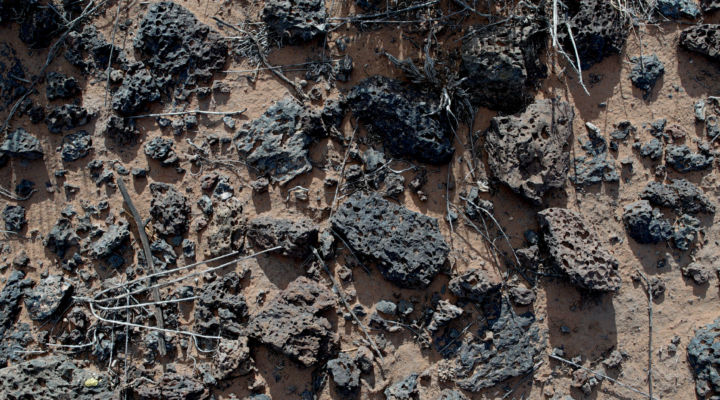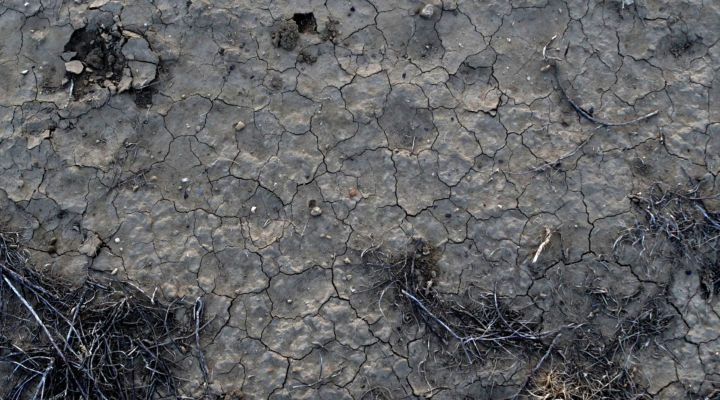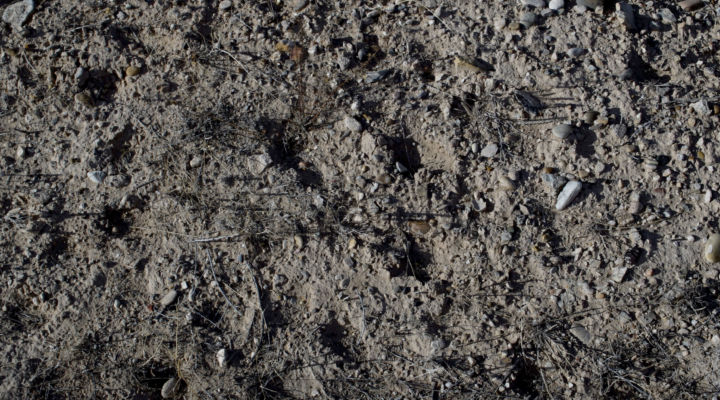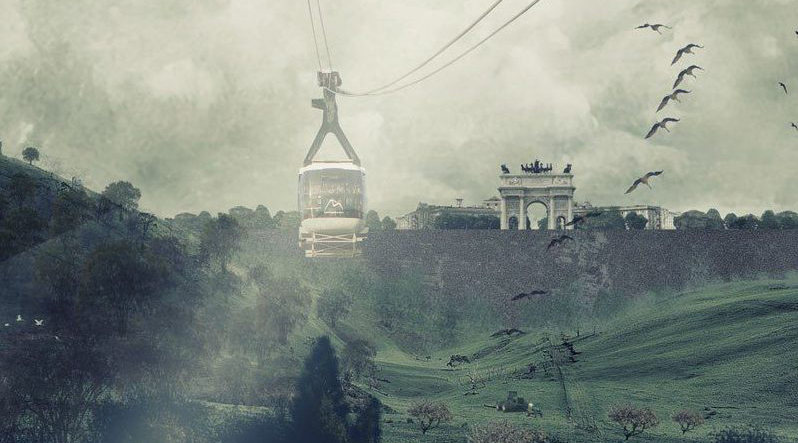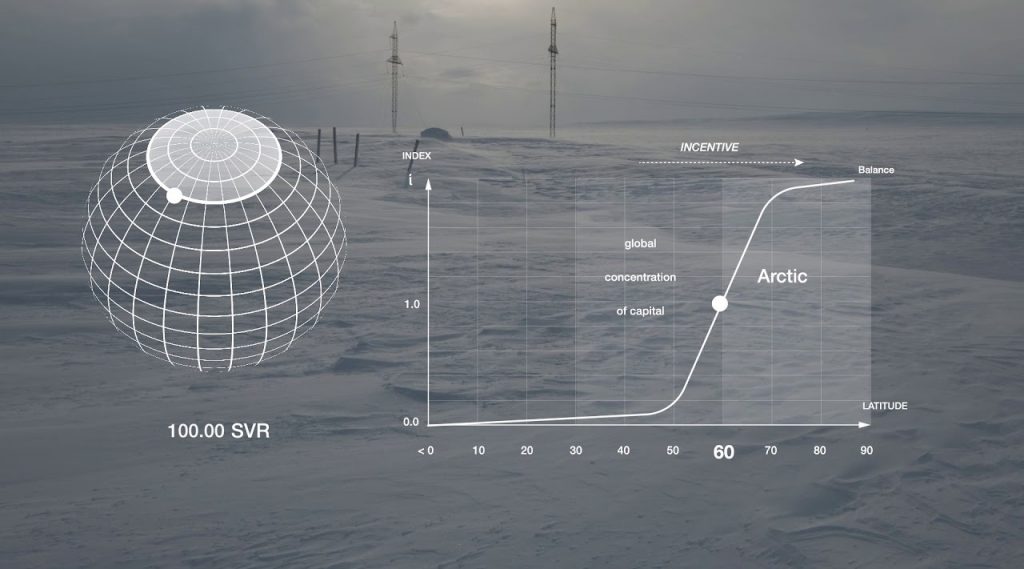
This text is part of the research project An Archaeology of Containment: Exhuming the perpetual architectures and territories of nuclear waste. Revision of the English translation by Daniel Lacasta Fitzsimmons.
As the Reddish Cloud Darkens
Looking through a dark glass provided to protect our retinas, we are first dazzled by an indirect light, much stronger than expected, followed by flames and smoke, the sky rising slightly above the surface. After three seconds, once we are able to look at it directly, a reddish glowing ball of smoke rises leaving behind a thick stem of dark brown. The surrounding blue glow indicates high radioactivity due to the gamma rays emitted by the cloud. We feel the intense heat radiation all over the exposed parts of our bodies. After about 45 seconds the sound wave arrives, and it strikes us as being much weaker than anticipated. Our eyes, exposed to the indirect light from the surrounding mountains, are now completely blinded, and we can feel traces of the after-image 30 minutes after the shock.1
At the Trinity test site, at around 5:30 in the morning on July 16, 1945, this is what one would have seen and felt looking toward ground zero from base camp. When the atomic bomb was tested near Alamogordo, New Mexico, Los Alamos’s scientists were the first humans to witness the power of a nuclear weapon.2 Accompanied by their families and dressed like it was any other day—the consequences of radiation were still barely known—they celebrated the event: the ultimate weapon and key to the end of the Second World War had been a success.
Green Glass
While members of the military looked up toward the sky, watching the landscape light up with colors and taking pictures of the toxic cloud staining the skies, it was under their feet, in the desert soil surrounding the site, where one of the greatest transformations in geological history was taking place. As described by Timothy Morton in his book Hyperobjects, sixteen milliseconds after the detonation a weird light-green glass was formed as the explosion fused sand at temperatures ten thousand times hotter than the surface of the sun.3 This new man-made mineral, called Trinitite, also known as Alamogordo glass, was one of the main residues left after the detonation of Trinity’s plutonium-based nuclear bomb—a geological transformation that, as reported in TIME magazine in September 1945, covered the territory with a strange substance unknown until then, totally oblivious to the natural composition of the earth so far: “Seen from the air, the crater itself seems a lake of green jade shaped like a splashy star and set in a sere disc of burnt vegetation half a mile wide. From close up the ‘lake’ is a glistening incrustation of blue-green glass 2,400 ft. in diameter, formed when the molten soil solidified in air. The glass takes strange shapes—lopsided marbles, knobbly sheets a quarter-inch thick, broken, thin-walled bubbles, green, wormlike forms.”3

The deposition of this layer signifies a decisive geological moment, marking and making visible the definite evidence of the human terraforming of the earth as such. Yet, it also implies an ontological transformation around the concept of geology itself, one that reconfigures its relationship with geopolitics, economy, technology, and media, as the nuclear waste that will slowly transform and contaminate the earth’s soil will also mobilize complex political agendas. Thus, the history of nuclear waste must be read as a stratigraphic process, as an accumulation of precipitate material, but also of political, economical, and technological strata.

Critical Media Geology
Although the earth from then on will hold throughout its circumference a thin layer of radioactive matter, in order to generate a contemporary critical geology that reexamines its consequences the materiality derived from nuclear experiments should not only be examined on the ultimate layer of the earth’s crust, but also in the particles that form its environment, in the technologies that mobilize its materials, in the political economies that chose the territories where it happened, and in the media objects that render it visible.5 These are complex mobilizations that challenge the implications of the term omnipresent in the contemporary ecological debate, the Anthropocene.
Derived from the volatile nature of radiation and its invisibility, nuclear waste expands the material, geological, and territorial implications of technology. If, as Jussi Parikka argues, during the second half of the century national, supranational, and other institutional organizational bodies were forced to think about the future of technology as something “below the turf,” it is due to the nuclear detonations, meaning they will have to face viscous and pervasive substances such as nuclear radiation, putting their containment strategies, both physical and conceptual, in crisis.6
In this context, the Anthropocene should be understood as a conceptual tool that helps demonstrate that geology does not refer exclusively to the ground beneath our feet. In his book A Geology of Media, Parikka argues that it is, in fact, constituted by media and technological relations and environmental and ecological realities.7 Geology therefore becomes de-territorialized in the concrete ways that the nuclear technologies and waste themselves become mobile.
Radiation, which is everywhere, connects objects, technologies, rocks, and humans, despite their vastly different timescales. The impossibility of containing nuclear waste, the new man-made viscous “hyperobject,” to put it in Morton’s terms, can be compared to the impossibility of conceptually containing its real consequences by naming this era the Anthropocene. Because the transition to invisibility that the residues of nuclear waste imply entails a process of de-territorialization and denaturalization, creating a new deep-time geological space challenges the notions of temporalities, boundaries, and limits that shape modern history. In this context, perhaps both the concept of nuclear containment and the idea of a final human geological era simply become the last relics of modernity, because the territories of nuclear waste that massively out-scale our notions of both space and temporality might have even destabilized the modern idea of time and space as containers.
Media Objects of the Anthropocene
If the detonation marked a turning point in the history of modernity, causing a technological and military transformation that helped redraw the world’s political map during the second half of the twentieth century, it also triggered a cultural and ontological shift around the binary dualisms on which such technologies were built, destabilizing the notion of a world divided into opposites: the natural and the artificial, the inner and the outer, the safe and the toxic, redrawing a nonhierarchical definition of human interventions on the territory.
The summer of 1945 transformed the Trinity landscape into a set of technical, military, political, and economic protocols, a transformation that was only made possible thanks to a series of architectures, technologies, and media apparatuses that hosted, recorded, and narrated the events. Together with technical specifications, numerous photographs, the data collected by devices scattered around the area, and the written testimonies of the military personnel involved in the Manhattan Project, four hand-drawn clouds were compiled in what became the Trinity Report.8

Drawn freehand, delineating a nonexistent shape through continuous lines, the nuclear cloud sketches not only portray, as phenomenological descriptions, the events of the morning the bomb was detonated, but they also reveal the uncertainties related to its consequences. The fact that they are subjectively drawn from the witnesses’ memories, a week after the test, makes it somewhat evident that they were not conceived as objective scientific records of the events, but rather that they expressed the will to control a situation that was already starting to become uncontrollable. As attempts to delineate the limits of the nuclear cloud, they became the first of the many containment operations linked to nuclear technologies, closed contours that can be read as desperate attempts to also contain its effects.
The image of the nuclear mushroom becomes then a carefully constructed symbol, a mediated image that became part of a precisely designed narrative and carefully constructed visual imagery. Nothing other than a mirage, an ephemeral moment captured by a technological device or drawn by the military’s hand, it hides the more complex reality of two unstable environments mixing, one intoxicating the other, and both creating a noxious, post-natural, unbreathable atmosphere.
In this sense, these drawings are, together with numerous documents that articulated the narrative of modernity’s technological development, media-archaeological records that, again, might help us destabilize the idea of the Anthropocene as an exclusively geological or environmental concept. In such a new hyper-mediated post-natural era, one that gives new meaning to the relationship between nature, territory, technology, and aesthetics, it should also then be read as part of a media apparatus, one designed as a means to conceal (in a broad sense) the unknown consequences of new devastating technologies.
Thus, in the context of nuclear waste, the concept of the Anthropocene does not mean simply a reference to “nature,” but to an environmentality understood and defined by a “technological condition.” As Parikka argues, the environmental expands from a focus on the natural ecology to an entanglement with technological questions. If geology is de-territorialized due to the viscosity and toxicity of the new technological materialities, nature is then implicitly also denaturalized.9
The complexities that derive from such confrontation processes relate to the political agendas that these sites have mobilized through history, and also to the technologies, protocols, legal frameworks, and media apparatuses that have been built around them. Through these media objects, the Anthropocene becomes directly related to the geopolitics and power dynamics that have marked modernity through its technological advances, a media construction that cannot be attributed to the whole of humanity but must be studied as a very specific narrative derived from specific technological advances. And it is perhaps through the very discontinuity of postnuclear media objects that a new approach to the Anthropocene as a history of the leaks derived from its geopolitical and technological forces is possible. Because in the context of nuclear waste, fixed and binary categories such as “visible” and “invisible,” “technical” and “cultural,” “safe” and “toxic” lose meaning, generating a new perspective, one in which the containers of modernity, its terms included, seem to have definitely lost their capacity to contain.

1Testimony by V. Weisskopf. See Trinity (Los Alamos, NM: Los Alamos Scientific Laboratory), 1976.
2Lillian Hoddeson, Paul W. Henriksen, Roger A. Meade, and Catherine L. Westfall, Critical Assembly: A Technical History of Los Alamos During the Oppenheimer Years, 1943–1945(Cambridge: Cambridge University Press, 1992).
3“Science: Atomic Footprint,” TIME, September 17, 1945; accessed May 26, 2018, http://content.time.com/time/subscriber/article/0,33009,854500-1,00.html.
4Timothy Morton, Hyperobjects: Philosophy and Ecology after the End of the World(Minneapolis: University of Minnesota Press, 2013).
5Ibid.
6Jussi Parikka, A Geology of Media (Minneapolis: University of Minnesota Press, 2015).
7Ibid.
8Pravin P. Parekh, Thomas M. Semkow, Miguel A. Torres, Douglas K. Haines, Joseph M. Cooper, Peter M. Rosenberg, and Michael E. Kitto, “Radioactivity in Trinitite Six Decades Later,” Journal of Environmental Radioactivity 85, no. 1 (2006): 103–20.
9Ibid.


